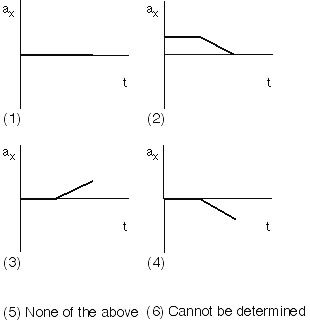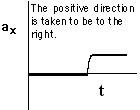A2L Item 001
- Description: Identifying the correct acceleration graph for a rolling ball on an incline.
- Goal: Relating physical understanding of an object's motion to a graphical representation of acceleration.
- Source: UMPERG
- Keywords: Mechanics, Graphing, Acceleration
The question for students:
A soccer ball rolls slowly across the road and down a hill as shown below:

Which of the following sketches of ax vs. t is a reasonable representation of the horizontal acceleration of the ball as a function of time?

Commentary for teachers:
Answer
 We will assume that rolling friction between the ball and road surface is small and that air resistance can be ignored. We will also assume that the ball does not leave the road surface at the top of the hill. If these assumptions are satisfied, the ball will roll across the level road at a (nearly) constant velocity. As it rolls down the hill, the ball will speed up, producing a constant acceleration in the direction of motion. There will be a nonzero component of acceleration pointing to the right. The graph at the right is a reasonable representation of the horizontal acceleration as a function of time. For our assumptions, answer (5) is the best choice.
We will assume that rolling friction between the ball and road surface is small and that air resistance can be ignored. We will also assume that the ball does not leave the road surface at the top of the hill. If these assumptions are satisfied, the ball will roll across the level road at a (nearly) constant velocity. As it rolls down the hill, the ball will speed up, producing a constant acceleration in the direction of motion. There will be a nonzero component of acceleration pointing to the right. The graph at the right is a reasonable representation of the horizontal acceleration as a function of time. For our assumptions, answer (5) is the best choice.
Background
Context for Use: Give after students explore the vector nature of acceleration. Formal (quantitative) kinematics is not required.
Assessment Issues: (1) Can students recognize when an object is accelerating? What criteria do they use? (2) Do students perceive nonzero horizontal and vertical components of acceleration? Do some students think that the acceleration is in the y-direction only? (3) Do students think that the acceleration graph looks like the sketch of the road on which the ball rolls? What process do they use to construct a graph of acceleration versus time? (4) Do students confuse the different motion quantities? For example, do they interpret the graphs of acceleration versus time as velocity versus time graphs?
Questions to Reveal Student Reasoning
-
Where does the ball speed up? Where does it slow down? Why does its speed change?
-
What is the direction of the ball’s acceleration while it is on the hill? Does the ball accelerate to the right? Does the ball accelerate vertically?
Suggestions
Help students construct the horizontal (and vertical) velocity vs. time graph for the ball. If students have been exposed to forces, draw a free-body diagram and use it to find the net force.